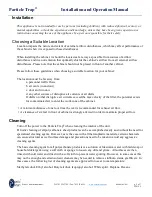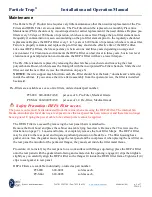
Particle Trap
®
Installation and Operation Manual
Static Clean International:
Tel: 781 229-7799 / Fax: 781 229-4555
www.staticclean.com
Made in USA
p. 4 of 7
V2019.2
Installation
This appliance is not intended for use by persons (including children) with reduced physical, sensory or
mental capabilities, or lack the experience and knowledge, unless they have been given supervision or
instruction concerning the use of the appliance by a person responsible for their safety.
Choosing a Suitable Location
Location impacts the nature and extent of external airflow disturbances, which may affect performance of
the cabinet when it is exposed to these disturbances.
When installing the cabinet, it should be located as far away as possible from sources of airflow
disturbance and in an orientation that optimally shields the cabinet’s airflow from all external airflow
disturbances. Please note that the cabinet should not be placed in front of another cabinet.
Please follow these guidelines when choosing a suitable location for your cabinet:
The location must be far away from:
a. personnel traffic flows
b.
air vents (in and out)
c.
door and window
d.
any other sources of disruptive air currents or air drafts
If drafts or other disruptive air currents exceed the face velocity of the filter, the potential exists
for contaminated air to enter the work zone of the cabinet.
•
A minimum distance of one foot from the rear is recommended for exhaust air flow.
•
A clearance of six feet in front of cabinet is strongly advised in order to maintain proper airflow.
Cleaning
Turn off the power to the Particle Trap
®
when cleaning the interior of the unit.
Periodic cleaning of all
polycarbonate sheet products can be accomplished easily and without the need for
specialized cleaning agents. However, as is the case with all thermoplastic materials, certain chemicals
can cause structural as well surface damage and precautions need to be taken to avoid any aggressive
cleaning agents.
The basic cleaning agent for all
polycarbonate products is a solution of lukewarm water with mild soap or
household detergent, using a soft cloth or sponge to loosen any dirt and grime. All surfaces are then
rinsed with cold water and dried with a soft cloth to prevent water spotting. However, in some cases this
may not be enough and certain solvent cleaners may be needed to remove stubborn stains, graffiti etc. In
these cases, the following list of cleaning agents are approved for use at room temperature:
Methyl alcohol, Ethyl alcohol, Butyl alcohol, Isopropyl alcohol, White spirit, Heptane, Hexane
Summary of Contents for PT6000
Page 1: ...Original Language ...







